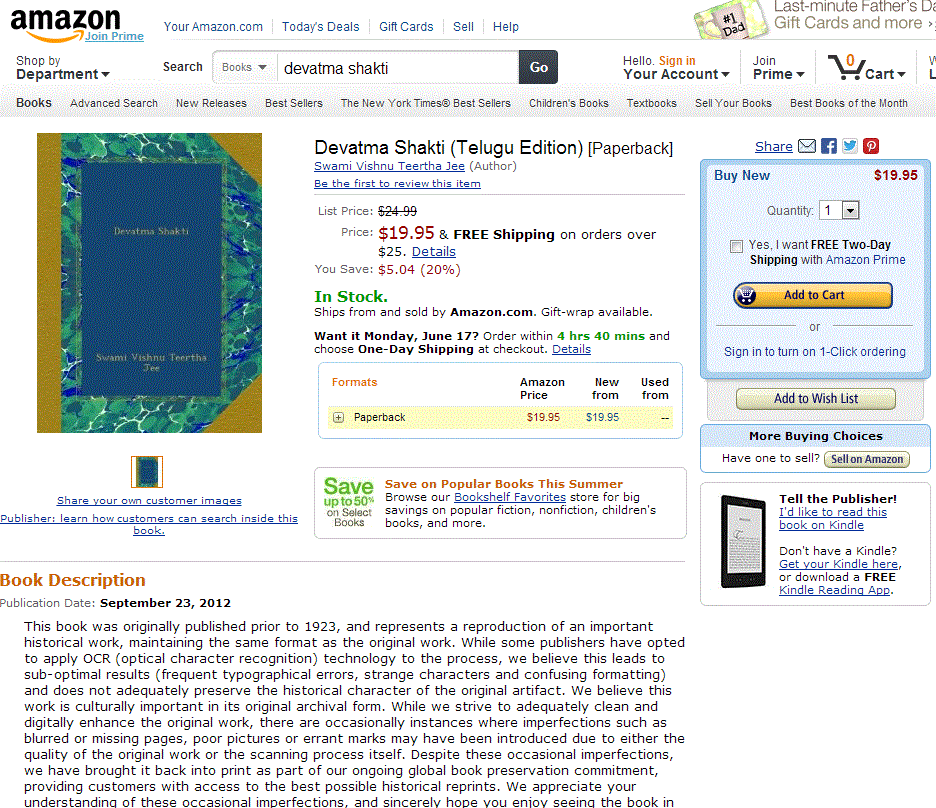Shakti (Kundalini) Divine Power. by Swami Vishnu Tirtha
Maharaj, with Forward by Mahamahopadhyaya Gopinath Kaviraj,
J.A., Formerly Principal, Government Sanksrit College,
Varanasi,1962
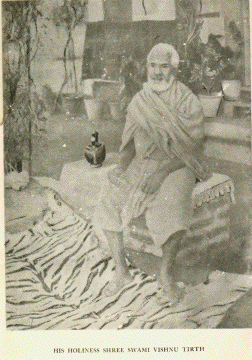
His
Holiness Shree Swami Vishnu
Tirtha
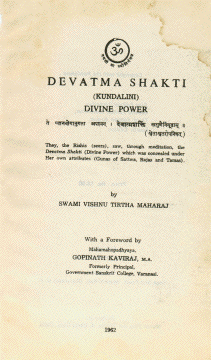
INTRODUCTION
Religion is an integral part of
sociology. It has not yet become obsolete or a thing of the
past but has still a firm hold on the teeming masses of
humanity. Of -recent years, there has been a sporadic rising
of anti-religious movements, taking their initiative -from.,
the materialistic outlook of the -Soviet Russia, but it is
more certain than otherwise, that all such attempts are
doomed to failure. The reason is not far to seek. A man is
by instinct a religious being ; there is a natural yearning
in him for something that is not of his sensual or
intellectual pleasures, but is for something beyond. Why
then these anti-religious movements ? Because most of us are
sick of bloodshed, exploitation, and warfares in the name of
religion. The followers of different religions have in the
past freely made use of inquisitions and throat-cutting of
those who differed from them in their mode of. worship.
India had a name for toleration and always had been
extending a hospitable hand to all whosoever sought refuge
on her land. Diverse faiths, some of them even atheistic,
found here full opportunity to spring up, grow and develop
side by side, scholars taking delight in their ‘comparative,
studies and mutual exchange of thoughts. Votaries of each
had full liberty to give an exposition of their views. They
invited criticisms from others, and listened to them with
toleration and dignity. Such was the India of the: past, but
much water has since flown under the bridges and the
episodes of the present-day communal tensions and religious
intoleration are sufficient to make any sober-minded person
to hang down his or her head in shame. Places of worship are
sometimes used as sermon. halls for preaching hatred and
bloodshed. Cold-blooded murders, stabbing of. innocent
persons and regular fightings with lathie, swords and
daggers are of common occurrence. This has set many a brain
thinking to find out some via media for restoring harmony
between different sects which is so essential for the common
weal and prosperity of the whole country. Sometimes one is
led to think that the day is remote for the consummation of
that much sought for peace and tranquillity, but a ray of
light at times streams forth- portending. the birth of a
universal: religion n based on sound principles preaching
common brotherhood of mankind, letting every individual live
and let live his neighbours in peaceful communion with God
in his or her own way. Under the present state of affairs
the country is labouring in the throes of its birth.
Hinduism with its multifarious branches affords the
evolution of such a one, covering the, ground of them all
and having even catholicity enough to embrace within its
fold Islam and Christianity. It does not imply that the
different religions should die out to make room for the
inception of the new one. They have developed into
institutions built on the foundation of sound philosophical
truths. Each religion was meant to meet the needs of the
society of its birthplace and give rise to a culture most
fitted to its surroundings enriching the civilisation of the
whole mankind in general. The great teachers of the past
have been serving to this date as torch-bearers to
individuals in their march towards the goal of spiritual
realisation and their pious memories play no small part in
contributing to build up our civilisation and culture so
precious to every one of us. We owe the best of what we have
to those great souls of the past. And it is but natural that
their revered names and pious memories are so dear to us.
Humanity cannot suffer to forget Ram, Krishna, Buddha,
Christ, or Mohammed. Our degradation in respect of our
intolerance towards those who differ from us, is not of
their heritage, but has crept in for dishonouring and
defiling their holy names. No teacher ever suggested
splitting of human blood for the propagation of his mission
or in commemorating his name.
Every religion has a philosophy
behind it and in the beginning it started with that
philosophy but as time rolled on, it accumulated on its
surface much of superstitions, ceremonials, and rituals
often not warranted by it. Sometimes the beauties of a
particular faith and its high ideals are eclipsed by crude
and lifeless ceremonies, the blind observance of which is
fondly adhered to by their followers and the least
interference therein excites them to extravagant rashness
bordering the extreme savage fanaticism. But the victim of
such fanaticism is often ignorant to understand the very
religion he professes, and probably like a brute he commits
arson in the vain hope of attaining favours of the Merciful
God or in the expectation of an uncertain heaven hereafter.
He is often deluded by a false idea of serving his religion
as a defender of faith. He little knows that he does a
disservice of a magnitude of the highest degree to the cause
he loves dearest and harms the society of which he himself
is a member by causing disturbances and creating
disruptions.
Religion is a means for ennobling
one’s heart for the realisation of God within and to this
end one’s prayers are day after day offered for His
benedictions. How this end can be achieved through bloodshed
passes one’s comprehension. True religion consists in
communing with Him through meditation and intense emotion of
love for Him and His creation. God is not to be found in
temples, churches, or mosques, but is to be felt only in the
innermost recesses of one’s heart. Rites and ceremonies are
mere accessories. Be he a Christian or a Jew,
a Mohammedan or a Parsi, a Hindu or a Sikh, a Buddhist or a
Jain, if he is sincere in his religion, he has to purify his
heart of all evils, because God resides in the holy temple
of heart and not in congregations of mobs, or within the
mere walls of bricks and mortar. A comparative study of
different religious systems would show that despite wide
differences of their rites and ceremonies they are at one in
essence. We foolishly in our zeal of enthusiasm attach the
whole importance to rites and discard Truth by denying the
very existence of God through felling down living temples of
human bodies. Was not man created after God? He verily
cannot be found in temples of bricks and mortar if He is
absent from heart. Let us grasp the divine essence which
like an under-current links diverse faiths running common
through their super divergencies, and cast off the
accretions. In due course a religion sounder in principle
and resting on terra firma of tolerance and universal
acceptance would be evolved.
As Vedas sing in the following
verses:
May we know that Supreme. Bring,
may we meditate
upon that High God, may our vital forces direct us
towards Him.
Him only by knowing one
transcends death, there is
no way other than this.
Higher than this is
Brahman, the Supreme, the Great.
Hidden in all things, body by body,
The One embracer of the universe
By knowing him as Lord men become
immortal.
I know this mighty
Person
Of the color of the sun, beyond darkness.
Only by knowing Him does one pass over death.
There is no other path for going there.
Than whom there is naught
else higher,
Than whom there is naught else smaller, naught
greater,
The One stands like a tree established in
heaven.
By Him, the Person, this whole world is
filled.
That which is beyond this
world
Is without form and without ill.
They who know That, become immortal;
But others go only to sorrow.
Svetasvatara
Upanishad 3.7-10
Concisely this is the goal of all
religions and the way to achieve it lies through meditation
to which end all our energies must therefore be focussed.
Religion is therefore mostly a personal concern and consists
in the practices of meditation and communion. In Sanskrit
language they are respectively called Dhyana and
Yoga.
In this short work we have attempted
to explain on scientific lines certain ideas generally met
with in the study of Hinduism, the philosophy underlying and
their application to practical pursuits in the field of
spiritual knowledge. Some of them are philosophical axioms
and others pertain to practical exercises conducive to
spiritual realization, and of universal application and
acceptance irrespective, of caste, creed or
nationality.
It is hoped that even non-Hindu
readers too would gain by a sympathetic reading of its pages
and would find much thoughtful reading, helpful to their
respective religious quests on their own lines any
whatsoever. The author therefore has apologetically
acknowledged the temptation of writing this work in a
language not his mother-tongue, but of those who ruled over
this land, simply for the benefit of such readers who have
been bred and brought up under the influence of western
thought and civilization, that they may get an opportunity
of understanding and appreciating the very sublime thoughts
of the Great Master-Minds of pre-historic India, which she
has to date preciously preserved through so many upheavals.
of time for generations with a mission to build up a nobler
world with a peace loving spiritually advanced race of
humankind. Though the mode of expression is their own and
not necessarily in conformity with the taste of the present
age, the truths conveyed therein are the outcome of serious
and deep thinking, valuable universally for all
ages.
We are passing through an age of
physical science, and therefore we have become accustomed to
look at everything – secular and spiritual, physical and
metaphysical, superficial and transcendental – to judge them
in the light of standards laid down by the authors of
physical science, though they do not always apply accurately
and strictly to fields beyond its range. Every field of
research work requires both theoretical thinking,
observation and experimental work. Therefore a research
scholar of those fields strictly bound by the principles of
secular knowledge is apt to miss the finer truths of
transcendental spheres, and reliance on mere imagination and
theorising would often lead to half-truths and
superstitions. The path of a spiritual aspirant needs
therefore a cautious and vigilant research, a clear thinking
and inspired vision. Hindu scriptures – Vedic, Tantric, and
the later including the Puranas – hint at so many fine and
subtle ideas garbed in their allegorical language that they
perplex the brains of modern thinkers, and are usually
ignored as fictitious and mythical, the reason being that
more often it is found impossible to catch hold of the link
interlining the different planes of existence’s higher –
than our own, mere speculative thinking does not help there.
Another difficulty that confronts such pursuits lies in the
fact that higher mystic experiences do not agree with those
on the physical plane and at times they are found to run
counter. For instance conflicting forces that are at play on
the lower planes of existence with. such acuteness and
intensity, lose their force on higher planes and their
action Leelas down and takes a harmonious turn towards
unity. Disruption of forces is the cause of diversity and
their harmonious working tends, to unity, and therefore
during the process of creation the primary forces. go on
splitting into diverse channels, often conflicting with and
counteracting one another. Reverse is the path to be pursued
by the seekers of Truth.
Upanishads declare that in the
beginning of every cycle of creation He wills – “I”,the One,
may become many for creation”. His will was an infinite
source of tremendous creative energy, which began to radiate
and flow in all directions. Every individual ray of that
energy is full of inexhaustible and infinite living Power to
create and to perpetuate for all times, and these different
individual forces do clash and come into collision with one
another during their struggle for self perpetuation, losing
sight of their original single source. But during the
reverse path of self-realisation that struggle begins to
lessen, their flow tends to harmonize and ultimately merge
into the First Unity. In short, full consciousness of the
same original ‘I’ shines, throbs and pulsates in every ray
of individual egoism. Broadly speaking, the different planes
of existence are classified under three strata of (1) Pure
universal consciousness, (2) Mixed consciousness of unity
and diversity, and (3) Impure consciousness of diversities.
Deities and souls of jivanmuktas belong to the first plane
of Universal Mind, Yogis and spiritual aspirants to the
second plane of mixed consciousness retaining their
individualities with minds of separate consciousness,
tending towards universality and lower down are those
receding far from the universal mind, who are bound hard and
fast within the circles of their individual egoisms. The
inert physical plane devoid of all active consciousness is
the last step in the creative process, though it is a form
of the same fundamental will to create.
As such the way to self-realisation
consists in raising one’s egoistic consciousness centered on
the physical plane to higher and finer planes of spiritual
existence. The results of the ancient research work of
Indian Rishis in the domains of spirituality have been
handed, down to us in as clear a language as possible. They
philosophised on higher truths and defined and formulated
the principles of spiritual planes for the help of the
beginners. The critical side of spiritual study forms the
different schools of Indian philosophy.
In India philosophy is not an
academical study of theories built for merely satisfying an
inquisitive mind trying to reveal the secrets of Nature, as
is the case with the, occidental. In India philosophy forms
the very foundation., on which practical work is to be
carried out. The practical side of the work forms that
branch of knowledge, which is called Yoga. Yoga is,
therefore, not a branch of philosophy in the right sense,
but is really a practical science. The science of Yoga has,
as such, laid down, defined and formulated the higher
principles, though not necessarily with mathematical
accuracy, as a student of modern physical science would like
to expect. As the field of the practical work extends from
the physical plane to the highest spiritual domain, it has
different branches relating to the different planes and
aspects of approach. We have Hatha Yoga consisting mostly of
physical exercises. Mantra Yoga which deals with the subject
in its relation to speech, Laya Yoga, a branch of purely
psychic refinement, and Raja Yoga that transcends even mind
and steps into the higher domains of spirituality. We have
as well Karma Yoga, i.e., the philosophy of actions, a
preparatory step for spiritual training, Bhakti Yoga, that
branch of yoga which deals with the field of devotion and
Love for God, Dhyana Yoga, the science of meditation, and
Jnana Yoga which culminates in the full realization of
Divinity in One’s own self. A science is always a science
and is of universal application. It is not the monopoly of
certain class of men or nations, though much of the credit
for exploring this science goes to the ancient Rishis of
India. Vast treasures of Sanskrit literature contain
numerous texts treating exhaustively one or more of its
different aspects separately. No single text is sufficient
to deal with at full length the whole scope of the subject
in all its details.
In the following pages I have
attempted to present to the English readers certain salient
features of the Hindu system of the yoga philosophy. An
attempt is made to put the subject in the light of modern
thinking and I have tried to explain some of the connected
ideas and theories on scientific lines, though the attempt
is not always an easy task. In support of my expositions I
have tried to quote authorities from ancient sanskrit texts.
The ideas are old, simply their explanation is mine, though
not always in conformity or in accordance with the
expositions given by other thinkers. Therefore it is quite
possible that I might have erred at places, which I hope is
excusable in consideration of the abstruseness of the
subject in hand.
There are two schools of thoughts in
India. Both of them are unanimous with regard to the nature
of Atman as pure unalloyed with any foreign matter or
metaphysical substance. But they differ uncompromisingly in
their outlook of Nature, the Creative Principle, Prakriti.
One of them regards it as an independent existence, in no
way correlated with Atman, whereas the other school thinks
that it is not so, but is the manifestation of Atman’s’ own
Power. Naturally the practical courses prescribed by each
school for the realization of Atman should also differ, and
hence there exist two courses for practice. According to
the’ first course Atman has to be distinguished and isolated
from Prakriti and its products, and realized in its pure
essence, and according to the other the lower psychic
products are to be taken back to their immediate causes,
reversing the order of sequence of their creation,
ultimately the primary product or the highest creative
principle is to merge into Atman or Brahman–the only cause
of the whole creation. The first creative principle is by
that School named as the principal Prana instead of as
Prakriti, which in the course, of the creative process.
assumes other forms. The term Pram literally means the
life-principle, whereas the term Prakriti carries with it
the idea of an inert cosmic energy. Both the practical
courses cover the whole field of the science of yoga. Roshi
Patanjali pointedly prescribes the first method and hence
his science of yoga describes the state of realization of
self as Sattawa Purushayorannyatha-Khyati, i.e., discernment
and realization of the difference between Self and
Intelligence ; whereas the other school accepting the above
stage of realization proceeds a step further and finally
aims at a step where the individual Pram merges into the
Absolute. The second view finds favour in Upanishadas and
even in Pauranic and Tantric literature. Below is quoted the
instance of Yudhishthir from Shrimadbhagawat (1, 15, 40-42).
There it is said that on hearing from Arjuna the news of
Lord Krishna’s departure to Heavens, Yudhishthir, traversing
the whole course of yoga, step by,,step-dissolved the lower
principle into the next higher and finally effected the
merger of his personal consciousness into the universal. A
free translation of the verses referred to above is given
below.
Translation : Discarding there
all his ornaments and garments, cutting himself off from all
worldly attachments, and having subdued even his personal
consciousness, he offered his speech as oblation into the
fire of his mind, of the mind into Prana, of Prana into the
other (Apana), thereof, with its (consequent) creation into
death and of death into the five (principles of earth,
water, fire, air and ether), next having offered the five
into the triad (as oblation into the fire of the three Gunas
of Sattwa, Rajas and Tamas), the saint offered the three
into the one (Mahat tattwa), and having thus offered
everything to the fire of self, effected complete merger of
his Self into the eternal Brahman.
Offering of oblations is the mystic
merger of lower principles into their immediate causes. The
process is compared with a Yajna in order to give them the
sanctity of a religious worship. Compare also Bh. Gita, Ch.
4, verses 26-30.
Thus the whole course is a chain of
union of (1) speech with mind, (2) of mind with Prana,, (3)
of Prana with Apana, (4) of Apana with Death by overcoming
it through conquest of the five principles (Bhootajaya) (5)
dissolution of the five principles along with their
corresponding sense powers into the triad of Sattwa, Rajas
and Tamas, (6) – merger of gunas into Mahat, (7) merger of
Mahat’ into the self, (g) and finally, ultimate merger of
self (personal consciousness into the absolute).
Vedic philosophers regard the whole
creation on physical and metaphysical planes as a play of
different forces, all being different forms of one universal
cosmic energy or Power (Shakti), which comes into
manifestation from the all-pervading and all-powerful
Brahman, the phenomenon may be compared with the formation
of mists, clouds, lightning, thunder, rains, hail, snow, and
so forth from an all-pervading atmosphere of vapour. Every
manifestation of the cosmic power is followed by a
corresponding merger completing one cycle. The infinite
Cosmic Power appears in the dynamic state during the
creative process and after having accomplished a particular
item in hand conceals itself with its infinite potentiality
in the static residual form at some basic centre of that
individual item. In this residual form it is known as
Kundalini Shakti or the Coiled Power, which when uncoiles on
being roused to action begins to retrace its -reverse path
to its parental source, as is the case with electric energy.
Every phase of the universal creative phenomenon is an
outcome of the energy in operation through dualities of
opposite charges. As such its manifestation on different
planes of. the physical and psychic’, there runs the thread
of the same one universal power. The Indian mystics regard
it as a living force of. the universal Soul of the whole
creation. Procreative fluids, prana and apana, prana and
mind are the opposite charges of that force at different
planes-physical, astral and psychic. When the two opposite
charges unite on a particular plane, they give rise to
another set of a duality of, charges on the next subsequent
plane. When the Residual Static Coiled Power is once roused
at its basic centre, it commences its upward journey on
higher planes through the union. of opposite charges of its
manifestation, covering the whole course of mystic
progress.
This mystic power can easily be
roused through Shaktipata. A spiritual hand transmits a
spark of the highest potentiality into the astral body of an
aspirant and sets ablaze his or her Kundalini Power for the
upward spiritual journey.
I have attempted to throw light on
these subjects in this short book. The task , is huge and
needs perfect practical experience for an elaborate and
comprehensive treatment of the subject. I being but a novice
and a mere apprentice in this mystic science, confess my
inability to do full justice to the subject, and hope to be
excused for drawbacks that may be found in such a short
treatise.
Before I close I feel it my duty to
express my heart-felt gratitude to my friends His Holiness
Swami Sadananda Tirtha and Mr. U. C. Datta, Principal, Govt.
Inter. College, Moradabid, now Inspector of Schools at
Bareilly, for their revising the manuscript and helping me
with their valuable sugges tions. I also owe a deep sense of
gratitude towards Shri Mahamahopadhyaya Pt. Gopinath
Kaviraj, M.A., formerly Principal, Govt. Sanskrit College,
Banaras (a well-known scholar of tantric literature), who
has very kindly at the cost of his valuable time gone
through the manuscript and has favoured me with a short
foreword expressing his esteemed opinion. I take this
opportunity to express my great indebtedness to my spiritual
Master Shri Yoganandaji Maharaj also for his spiritual
guidance and his valuable collections of authorities from
numerous old texts that gave me material for the work. I
have quoted in this book certain passages translated from
his Hindi work Mahayoga Vijnana. Further I have full sense
of gratitude towards those friends too who have otherwise
very kindly contributed towards its publication and made it
available to the general readers.
Dated 18-12-48.
VISHNU TIRTHA
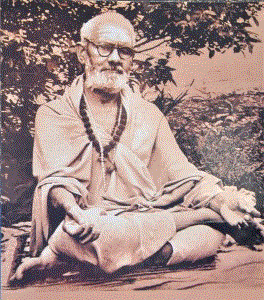
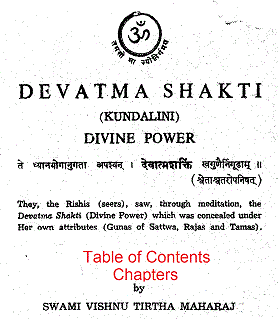
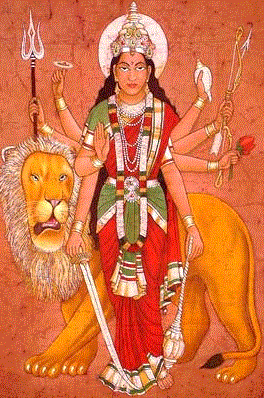
Buy Devatma Shakti on
Amazon
